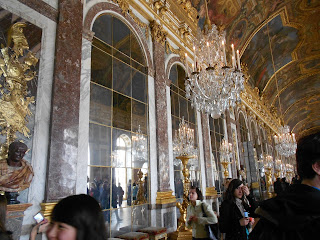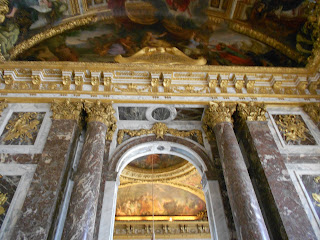Anyway I think everyone pretty much knows what the palace of Versailles is: probably the grandest existing palace in Western Europe (quite possibly the world but I suspect some Russian, Japanese, or Chinese ones could be equal to it), a huge monument to absolute monarchy, conspicuous consumption, and overindulgence. It is all those things, but also a lot more.
So just for starters, this place gets 7 million visitors per year - that is a LOT. The process of getting from the train to the ticket booth to the chateau is rather like being a herded cow. Going through the palace is even more similar to being a herded cow. We arrived about an hour after everything opened and you can see the crowds - although there are few people there compared to the high season.
An outside view of the palace chapel:
Despite how much Versailles is imprinted on history and memory, it was only in use as the government center for just over 100 years - a relatively short period for the almost 1,000 year old French monarchy. It was started in the mid 17th century under Louis XIV (the Sun King), and his great-great-great-grandson Louis XVI left it in 1789. So nearly everything here is in the Baroque or Rococo style.
Even aside from the art and architecture that makes up the palace itself, the artifacts inside make up an incredible museum. From the Wiki page some statistics: the palace is 67k sq meters; there are 2,153 windows, 2,300 rooms, 67 staircases, 6,123 paintings, 1,500 drawings, 15,034 engravings, 2,102 sculptures, 5,210 pieces of furniture and other objets d'art. Wow.
The palace and attached buildings not only housed the royal family but also had room for nearly all the nobility at any given time. That would include the king's much extended family and other important advisers and ministers; thousands of people lived in the palace and it was a community unto itself.
Of course, only a very small fraction of the palace is open to tourists these days, and we were lucky enough to go on a day when one not normally open wing was available.
Anyway, one of the first impressive places you get to is the chapel. This is just a picture of the ceiling, but the rest of it is equally as grand - it's probably one of my favorite areas of the palace. This is where the last two French kings (not including the Restoration) were married and their children baptized.
Even the walls of the palace are ornate, they nearly all look something like this:
Here is a reception room off the chapel:
The ceilings throughout the palace are almost all done in fresco, and they're one of the most impressive aspects of the art here. They're also some of the easiest pictures to take: the crowds push you from room to room with hardly any time to stop and properly take pictures. It's especially difficult to get shots of the furniture and such if you are short, and you'll see a lot of heads in my pictures.
Here is a portrait of Marie Leszczynska, a very cool lady, wife of Louis XV, mother of 10 royal children and a formidable Queen regent for her young son. She was considered a somewhat poor choice of consort at first, as the daughter of the deposed Polish king at the time, but she's one of my favorite French queens.
The rooms between the chapel and the Hall of Mirrors/Battle Room are all named after Roman gods and goddesses, and have frescoes pertaining to their symbolism. I forget which one this is, though, oops!
And here we have the famous Hall of Mirrors. You probably imagined the walls were essentially one big mirror, right? Nope, just lots of little ones. During the Franco-Prussian war the Prussians made this their headquarters - a strong symbolic move since this room was of particular political importance to the French. After World War I the Treaty of Versailles was signed in this room as well.
I believe this is the king's bedroom, but Louis XVI didn't like it much and only used it for ceremonial purposes. What ceremonies pertain to a bedroom, you might ask? Well, he often had to let people see him wake up and go to sleep. It was considered an honor to help him (and the queen, who had a different room) dress in the mornings.
Other rooms...
I think this was the bedroom of the dowager queens.
As I said before, one wing was open that isn't open all the time, it was the area where the three unmarried, non-nun daughters of Louis XV lived until their old age. It was extremely rare for French princesses to not be married off for diplomatic purposes, but when these three sisters came of age there were no eligible royals in Europe for them to marry. Rather than marry a member of lesser royalty or nobility they chose to remain single. This area was their private sphere, though when they were older they often wandered the palace wearing their dressing gowns (scandalous!) but no one wanted to stand up to them!
It's a lot simpler and more liveable than the rest of the palace.
Here are a bunch of Louis XV's daughters - there were eight girls in the family, one died young, and the last three lived in a nunnery for most of their adolescent and young adult lives.
And here is a very young Marie Antoinette, shortly after she arrived in France. She was only 13-14 at the time.
There is a LOT more to the Versailles visit, and I'll probably make a post for each section. Next up, the gardens.


























2 comments:
I can certainly see why Marie Antoinette wanted to escape to the Petit Trianon and her hameau behind Versailles. nice tour, thanks.
good overview Angie. I only saw the outside when I visited in '90, good to see the inside and some history from you. Uncle Jeff
Post a Comment